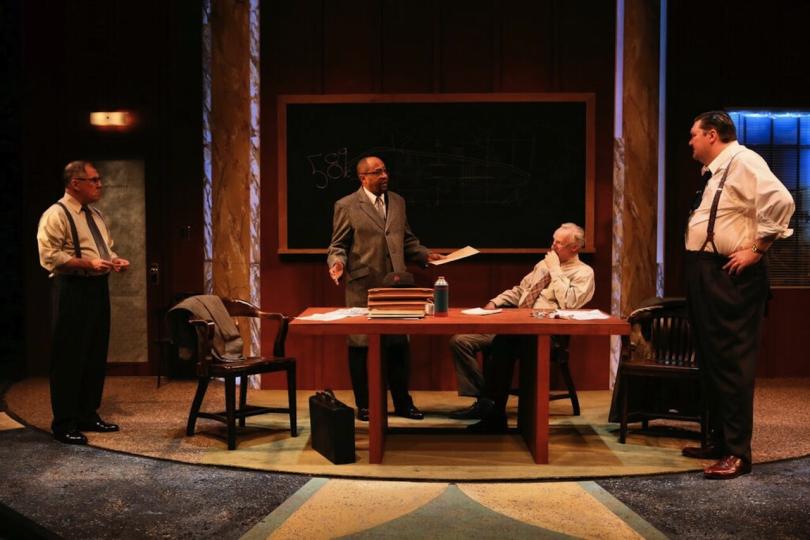A divide that’s still ours

On the surface, a lot has changed in St. Paul’s Rondo neighborhood from before the Civil Rights Movement to now. Where we today have superstores and a light rail line, there were once family businesses, churches and schools that serviced and sustained the strong black community between Marshall and University avenues. That’s all long gone, thanks to the other monstrosity cutting through the area: Interstate 94. In History Theatre’s The Highwaymen, that roadway is synonymous with progress.
Or, it is to the white characters. Josh Wilder’s play opens on three of them, laying out plans for the highway in St. Paul’s city hall in 1956. Their plan to cement city’s role in the country’s quick-changing landscape has a catch: it means cutting the Rondo neighborhood in half and displacing thousands of residents. Unfortunately, the only Rondo resident in the room is a janitor, and he’s just there to do his job. We follow him to a neighborhood barber shop where three community leaders respond to the plans by creating a proposal. If the city’s going to break their neighborhood apart, they at least want the roadway to be built below street level with a walking bridge over it.
From director Jamil Jude, The Highwaymen not only paints the realities of St. Paul’s racial climate then and now, but those of our country in this very moment in history.
Scarily significant
Wilder’s script is efficient and symbolic. As it moves between Rondo and City Hall, it becomes clear that the six characters represent different political outlooks. Barber Timothy Howard (powerfully played by Kevin D. West) uses his community role to insist the proposal be read — a simple request that the whites keep refusing to meet. The neighborhood pastor (Rex Isom Jr.) supports him, but only to a point. In the downtown office, retired city planner George Herrold (Peter Thomson) reveals the route was his idea, but that he just wanted to create a parkway to circulate people to local businesses. As the other whites turn a blind eye on his cautions against breaking up Rondo, he frets about his legacy. His idea, intended for good, was turning dangerous at the hands of politicians who had no clue what the affected citizens’ lives were even like. Sound like someone we know?
And, perhaps most ingeniously, city planning’s newest member (E.J. Subkoviak) does not have a government background at all, but was a baker who made lots of money and thinks he has the answers. He pushes hardest against Herrold’s demand to reroute the highway, claiming it will make Minnesota great, and that if sacrificing the black community is the price they must pay for greatness, so be it.
Sound like somebody we know?
Playwright Wilder makes this not just about St. Paul 60 years ago, but about our whole country, right now. He invites compassion for and understanding of the Rondo community in a way that completely hits home. We absorb the shock of residents forced from their houses with unfair compensation and the neighborhood’s transformation into one still suffering the consequences of “progress.”
Pushed from the spotlight
Director Jude built a fast-paced show, and Wilder a strategic one. Any narrative beyond the play’s message was only there because it had to be, but it worked. The actors added nuances, but it was almost too clear from the get-go what each character stood for, and they stayed mostly the same all the way through. But we satisfyingly got to see them fight harder as the play advanced.
The story focused much more on the white men’s half of the stage. It felt uneasy that a show about Rondo’s identity shuffled the black characters to the side. But it reflected how the government pushed Rondo residents out of the discussion and decision-making process. Most powerfully, Howard calls the white community out for complacency.
Because a drive through the neighborhood half a century later shows how far the actions of the Trump-like politician reached. As local images mix with ones from our recent racial history, we look at the city mirrored with others where inequality lives on, and how our Minnesota niceness camouflages racism as deep at the south’s. It’s relevant locally, nationally, in the past and in the present.
And it invites this question: the next time we merge onto I-94, in a rush or just looking toward our destination — our own pursuit of progress — will we think of who enabled that?
This thought and many others make the show crucial to see.


